Poseyville, Indiana is a small town (population just over 1000) located in the southwest corner of the state. Although you might think of Indiana as being cold and windy, this particular area is actually classified as having a humid, subtropical climate. This is great for Jerrilee LaMar and her husband, Scott because they are running a subsistence farm with all kinds of animals and a huge garden.
Last year, in our 35th Anniversary Essay Contest, Jerrilee told us how she and Scott made a big change in their lives from the world of business to a slower, healthier lifestyle:
Jerrilee’s Essay
My cheese making epiphany came about very subtly, but quite profoundly, as I reflect back on it.
About ten years ago my husband and I had become weary of the fast pace of our lives. I was the VP of Nursing at a large hospital system, and my husband was the operations manager of a solid waste business. We had both worked hard to get where we were, but found that we didn’t have much time for the simple pleasures that we had both enjoyed when we were first married.
My husband came from a farming background, and had always had a large garden growing up. When we were first married and were as poor as church mice, we had a vegetable garden every year and we put by our bounty for the winter. As we found ourselves further and further removed from that lifestyle, we started yearning for the time that we had together and the simple pleasures that we once enjoyed.
 |
| Louisa on the milk stand |
I had just earned my PhD in 2004, and was becoming increasingly concerned about the quality of the food that we were consuming. It wasn’t too hard to find organically grown local vegetables, but locally-produced raw milk was another thing altogether.
Indiana is a state where buying or selling raw milk for human consumption is against the law. I decided that we should purchase our own family milk goat. Little did I know that our lives would be changed forever by this decision!
We built a goat barn on our property, and my husband outfitted it with
the equipment to properly milk a goat. We bought our first goat (along
with her twin doeling kids) and brought them home. Nibbles was probably
the worst milk goat in the country. She didn’t produce much milk, and I
was the only human that she would tolerate.
 |
| Goat cheddar, made with a fruit press. |
We eventually ended up getting rid of Nibbles and purchasing registered Alpines. That is the point where I found out that I had more milk than our little family could drink, so I started making cheese. It was about this same time that I had also decided that I wanted to have the time to devote to our little homestead, and I made a career change from hospital executive to Professor of Nursing at the University of Evansville. I now have summers off to spend time with the animals, garden, and most importantly, make cheese!
I have taken my passion into the classroom where I discuss the benefits of raw milk and fresh cheese with my students. I have brought them in cheese to sample, and have introduced them to what fresh, whole, authentic food really is. Some students have actually come to my house to learn how to make cheese, bread, and home-brewed whole-grain beer.
My husband has also learned to make cheese, and keeps us supplied with yogurt, chevre and mozzarella. I can truly say that our cheese making journey has changed our lives in ways that I would have never imagined!
 |
| Jerrilee shares her chevre with her research students |
 |
| Louisa is a first time freshener |
Interview
Jerrilee
works
full time as a Professor of Nursing at the University of Evanston. (She received her Master’s degree in nursing, and her PhD is in Curriculum and Instruction.) She also writes for Elsevier (nursing textbooks).
She will be teaching nursing this fall at the
University of Evansville’s Harlaxton, England campus in a 17th century
manor house. She told us she has taught there in the past and it is right down the
road from the Stilton cheese factory! Her husband, Scott will be coming going for a few weeks later in the fall (after the
goats are bred). Jerrilee will be leaving in August and will be there until
mid-December.
Fortunately, she has summers off, because she and Scott have quite a large subsistence farm:
 |
| Harlaxton, England campus |
 |
| Scott making cheese |
What are you growing and raising on your farm?
We have ADGA-Registered Alpines and are currently have four
lactating does that we are milking, three doelings, a buckling and our
herd sire for a grand total of 9 goats. We get about 4 gallons of milk a
day, some of which goes into our soap that we sell at the New Harmony
Indiana Farmer’s and Artisan’s Market (I am a co-Market Master this
year). The other milk is used in our cheese and yogurt, and cooking
(and of course we drink it!).
We also have a small flock of about 25
chickens for eggs, and just butchered 10 broilers – we usually let our
broody hens set to replace our older layers each year, and we butcher
the extra roosters that we get. We have 4 ducks that we also keep for
eggs and meat. We have a Royal Palm Tom Turkey that a friend gave us (I
am looking for some hens for him), and a Chinese goose named Ava that
we keep as a watch dog.
 |
| Aging “cave” in pantry closet |
Ava loves the chickens and believes it is his
(yes, he is a male named Ava – I didn’t know it when I named him!) duty
to guard them from the coyotes, fox and other predators that seem to
visit us in the evening hours. Since we have had him, we haven’t lost
any of our chicks to those predators. Ava is also a pet and helps pull
grass in the garden – he is actually my favorite animal on our little
farm.
We also raise and butcher a pig each year. It was an interesting
endeavor the first time we butchered as my husband hadn’t done it since
he was quite young, but we studied it all out and had some of the best
pork I have ever eaten – the pig had been raised on whey from our cheese
– yumm!!
We keep bees and currently have six hives. We use the honey
for our sweetener, and render the extra wax to use in our lip balms and
skincare products that we sell at the Market.
We raise a huge garden
each year and put up all the extra bounty that we are blessed with. We
also grind our own grain for our baked goods.
We have nut and fruit
trees, grape vines and all kinds of berries.
We stay pretty busy around
here, but it seems to keep us out of trouble! I know that is probably
more than you wanted to know, but I really love sharing our
self-sufficient lifestyle with others!
 |
| Setting the chevre using warm bottles of water |
 |
| Draining the curds for chevre |
 |
| Final draining |
 |
| Setting yogurt with bottles of warm water |
















































































































































